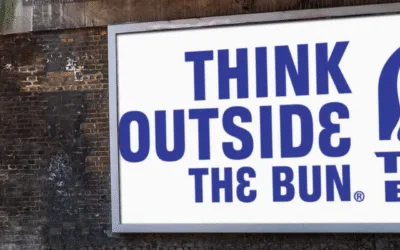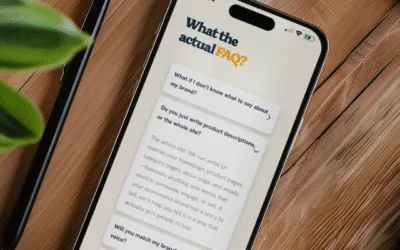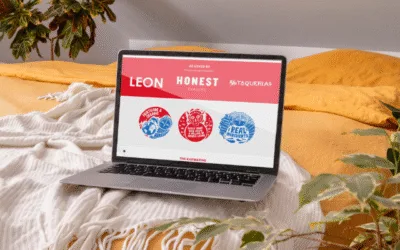Struggling to write scroll-stopping ads? Here’s how to steal a classic copy trick that’s backed by brain science and proven results.
Steal our 6-second before-after-bridge trick for 🔥 social ad copy
Discover how to write scroll-stopping ads that highlight customer problems without feeling icky using the super simple B-A-B copy formula.
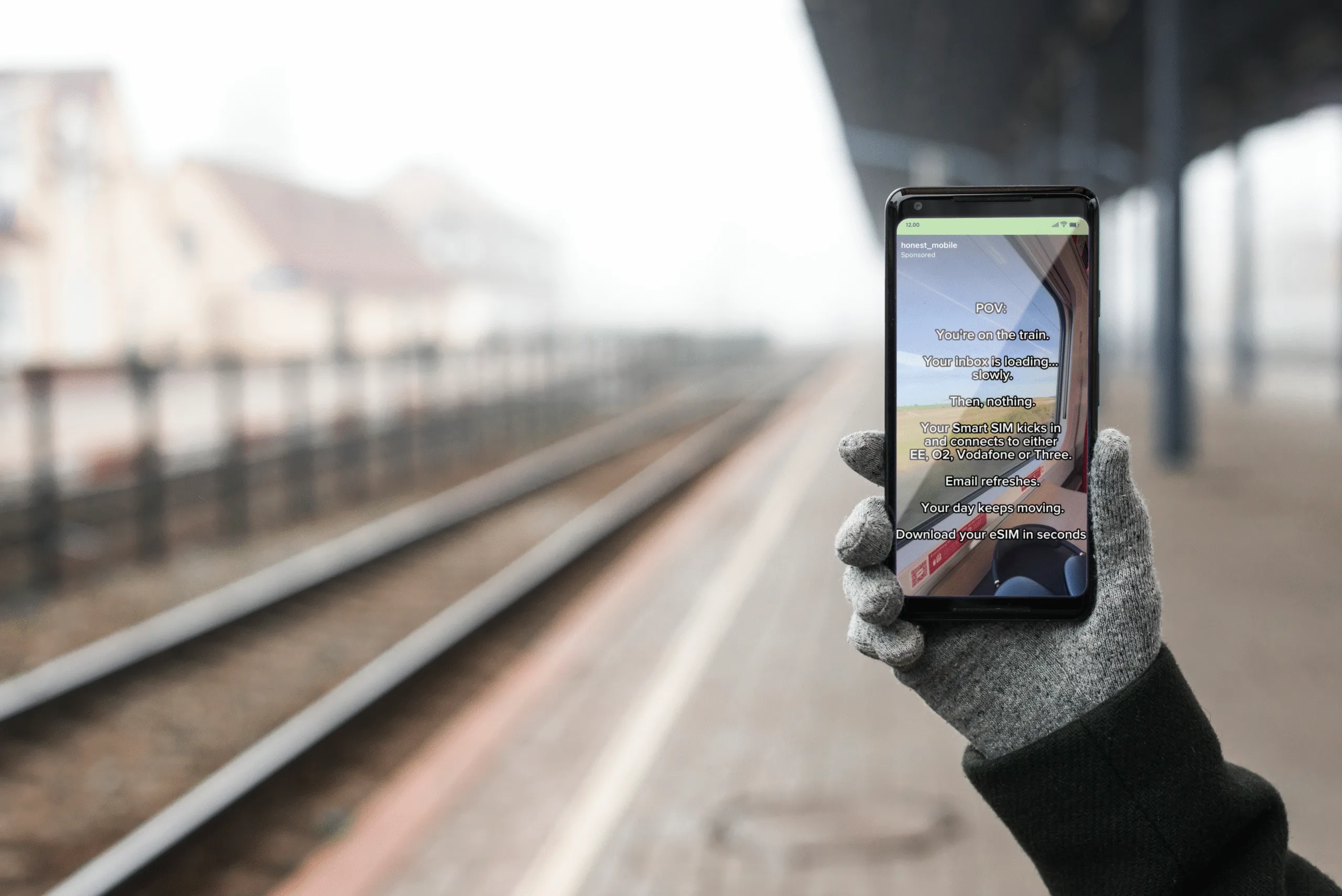
Get pro copy tips, branding tricks and e-comm insights directly to your inbox every Tuesday.
This week, we’re breaking down a super clever ad that popped up on our Instagram feed from Honest Mobile because it’s a fantastic example of another way you can use copy to grab, hold and convert customers attention, even if they don’t know who you are yet.
Let’s get it 👇
💡 This week’s big idea: talking about your customers’ problems is a fundamental element of copywriting. But it doesn’t have to feel icky.
The standard piece of advice when it comes to writing copy that sells has always gone a little something like this:
Find your customers’ biggest pain point. Agitate it. Make that pain feel real so the customer wants to fix it immediately. Then present your product as the solution to that agitated pain.
And 50 years ago? It 100% worked. And in certain niches? 100% still works.
But nowadays? Not so much.
Studies have found that audiences are becoming more and more turned off by ads and copy that feel manipulative or like they’re pushing too hard.
But at the same time, talking about pain points and showing how your product solves them is still a good idea.
It’s that agitation part that gets sticky. Because it’s really hard to agitate a pain point without slipping into manufacturing a consequence that feels icky.
So, how can you get all of the pain point benefits without going full Leo in Wolf of Wall Street?
By swapping the classic Problem-Agitate-Solution copywriting formula for the Before-After-Bridge (B-A-B) approach.
You still get to touch on pain points. You still get to sell the solution. And you miss all of the risks of the agitation section.
And best of all? It’s properly in tune with how people like to consume social media content too, so it’s more likely to get read and absorbed when people see it in their feed.
Let’s get into it 👇
Let’s start with a 🔥 ad we saw using the B-A-B formula from Honest Mobile
A few weeks ago, this banger of an ad popped up on our Instagram feed 👇

Isn’t it good?
Aside from the fact it feels platform native and “not like an ad”, it’s a perfect example of how if you really get your customers and understand their frustrations, you don’t need to agitate the pain at all.
You can just show them the pain, show them that there’s an alternative and then present your product as the solution. It’s dead simple.
🔎 What’s going on under the hood of this ad?
We love this ad. It’s so clever, despite being so simple.
Let’s break it down 👇
The ad opens with a customer’s POV before they tried Honest Mobile’s eSim. In this case, it’s being stuck on a train with no signal.
Notice how this is an almost universal pain point, but because it’s framed as a story, we fill in the blanks on our own.
Instead of saying the consequences of having no signal, Honest Mobile let our brains imagine whether we’re impatient for a reply from a client, waiting for a reply from your boss, waiting for an email to say we had an offer accepted on a house…
The context switches depending on who reads it. That’s super clever. It allows us to experience the pain point, rather than having it agitated for us. *chef’s kiss*
Then, they resolve that tension and give us a glimpse of what our world would look like after that problem goes away. And again, because it’s a narrative, our brains fill in the blanks on all the ways our lives would improve with it. (“I wouldn’t have missed that email if I’d had this!”)
Finally, they wrap it up with a bridge between the before and after by saying “Download your eSim in seconds.”
In 36 words and 6 seconds flat, they’ve told a full story that’s allowed us to experience the pain of not using their product, imagine our lives being better with it and then showed us how to take action.
Super smart. Love it.
Let’s compare that to the same ad that we’ve rewritten to agitate the pain 👇
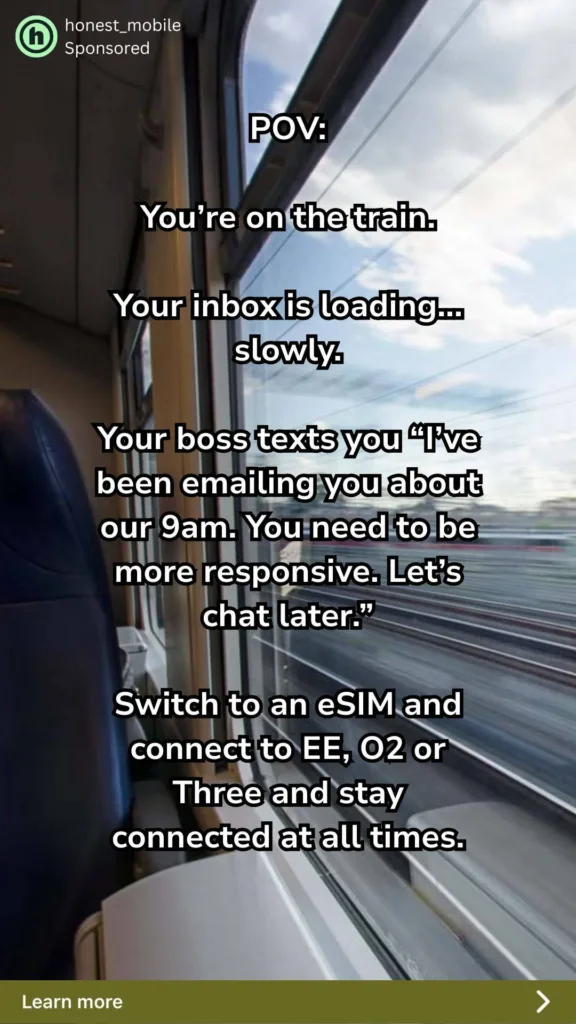
Sure, it makes the same points. But notice how that one feels a lot more manipulative?
Because we’ve been told we need to agitate the pain, we end up falling into the trap of trying to manufacture big consequences and bigger pain points.
So we dialed the consequences up to a level of “my job is at risk” in order to make the agitated pain feel urgent and concrete.
And that hasn’t just come at the cost of losing the benefits of our brains filling in the blanks, but it’s made the whole ad feel far more hard-selly too.
And our brains hate that.
🧠 What happens in our brain when we feel like we’re being sold to…
In news that’ll be surprising to nobody, our brains hate being sold to. (Do you ever walk into a shop hoping that somebody is going to pounce and start trying to get you to buy stuff?)
👉 Language that feels like it’s judging, shaming or trying to control your behavior infringes on our sense of autonomy. That causes something called reactance, where our brains basically dig their heels in and say “I will not budge”.
👉 When we sense manipulative intent, our brains get skeptical and push back against that intent. (That’s why those over-hyped agitations backfire.)
👉 A recent study found that loss-framing increases attention, but damages purchase intent. In other words, the agitation part of P-A-S does catch attention better but decreases purchase intent compared to gain-framed messages.
However, studies have found an antidote to the brain’s natural aversion to being sold to: storytelling.
Which is why the B-A-B formula is so powerful.
A quick and easy copywriting formula with storytelling baked in
In 2017, a study looked at whether a phenomenon called narrative transportation affected how our brains responded to marketing/branding messages.
Why? Because when your brain is in this state, it’s primed to push back against things less. Basically, it doesn’t question things as much as it would if it felt manipulated.
(For example, it’s why when the two of us watched Legolas surfing down the stairs at Helm’s Deep while firing arrows in Lord of the Rings, we thought it was the coolest thing we’d ever seen. Our brains didn’t go “erm, the laws of physics don’t work like that.”)
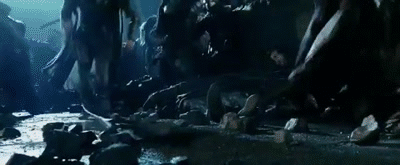
To see whether storytelling made a difference, the researchers ran two experiments using real “mini-film” ads (AKA, reel-style ads).
They found that storytelling in these reel-style videos consistently made viewers like the brand more and more likely to buy the product.
Even better, this was true even for viewers that weren’t the target audience, didn’t already love the brand and that had a dislike for ads in general.
In other words, our brain can’t resist a good story.
Which is why B-A-B, with its built in micro-storytelling, is such a handy copywriting tool to have in your arsenal.
How to use B-A-B for your brand’s top of funnel copy
We 💛 this formula because it’s so effective and so damn simple to execute.
And for busy social teams, it makes life as simple as finding a quick background video, overlaying some text and hitting publish. 5 mins from start to finish to a super-effective storytelling ad. Boom.
Here’s how to get it done 👇
Set up the before: pick a situation where your customers’ pain points are at their pointiest. Think of real, lived-in moments that your customers can relate to.
Then, write a short line or two that sets it up so they feel like they’re experiencing it.
(Pro tip: address the customer directly and drop them directly into the action. This is a writing technique called in medias res, where you bypass the traditional exposition to start the story at a point of high tension or action. It’s used to grab the audience’s attention quickly and create suspense, mystery, and a sense of immediacy. AKA, perfect for ads.)
Sell the after: do the same thing, but opposite. Find a situation where that pain point is completely eradicated. Then write another line or two where the customer can feel that relief.
Show your product as the bridge: write one line that shows your product as the bridge between the before and after.
In fact, you don’t even need to explain the bridge. A simple CTA does the trick because our brains fill in the blank of it being the how.
👋 A quick note on pain points for B-A-B.
In this scenario, the pain point doesn’t even have to be a traditional pain point. You can talk about even little things that frustrate people during their day and then show how you make them better.
Or, things can already be good, but they can be better.
(Remember, gain-framing works better for getting people to buy.)And that’s the beauty of B-A-B.
While the before is perfect for pain points if you have them, at its core it tells a story of how your product makes lives better in a way that our brains love to take in.
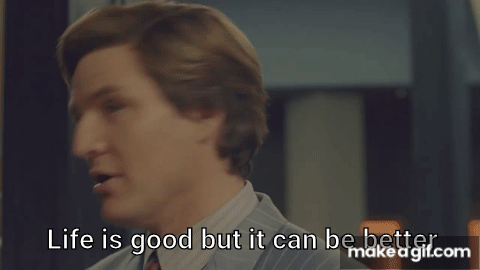
Let’s quickly put it to work for a fictional headphone brand
Let’s say we’re writing an ad for noise-cancelling headphones and we want to use the B-A-B formula to create copy for a reel that will run as an ad. How would we approach that?
We need to start by really nailing down the before state. To do that, we try to really zoom on everyday pain points caused by noise or distractions. Then we pick out really specific details that transport the reader into that scenario.
Think rush hour, noises, obnoxious commuters, hustle and bustle…
Then, we show the transformation.
Think a moment of pre-work zen, zoning out on the commute, being able to focus.
Then, we’d tie it all together with a memorable line about our product.
If we do all that, we end up with something like this 👇
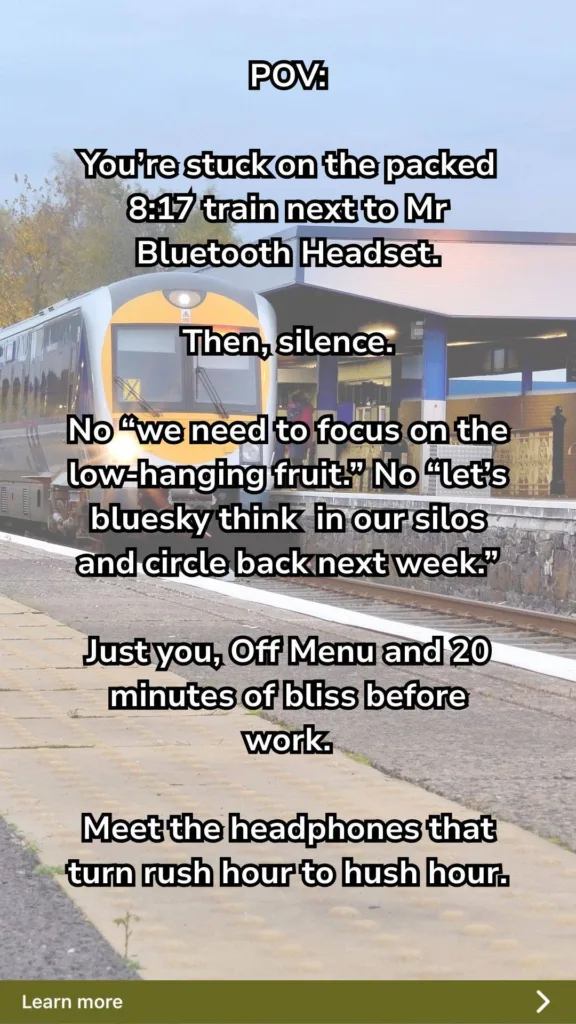
Notice how we pair dropping you right in the action (there’s that in medias res coming into play) with being really specific about the details (8:17 train, the annoying commuters, the podcast name) and adding sensory cues so that it feels more real and lived in?
By doing all of these, we’re making the reader feel like they’re on the train and making sure we hit all those narrative transportation beats that makes B-A-B ads like these so effective.
(Oh, and we threw in a bit of rhyme as reason bias with the tagline as well. But that was mostly to entertain ourselves. We’re suckers for a good rhyme.)
👋 Test this out for your brand
The best thing about this kind of copy? It’s such a quick and cheap way to test out new messaging and new angles while also making sure you’re doing it in a way that customers respond to. (AKA, not just throwing money down the Zuckerberg drain and calling it a test.)
Just write your new angle/messaging in the B-A-B format, overlay it on some b-roll footage and try it out on social media.
Need a hand figuring out some clever top of funnel copy? Feel like your headlines need a bit more oomph? Need to update your website copy or brand voice? We’d love to help. Grab a slot on our calendar and we’ll have a chat about how we can help. (No hard-sell BS of course.)
Dive into more free tips and tricks 👇
How to write FAQs that catch your buyers before they bounce in 15 minutes
Struggling with abandoned carts? Learn how to turn your FAQs into a high-converting, trust-building sales tool, in just 15 minutes.
Why we’re here for bringing back bold, imperfect copywriting
What do Marvel movies, French cinema, and rogue punctuation have to do with your copy? More than you think. Let’s get into it.
The weekly newsletter that takes your brand’s copy from “meh” to “hell f*cking yeah!”
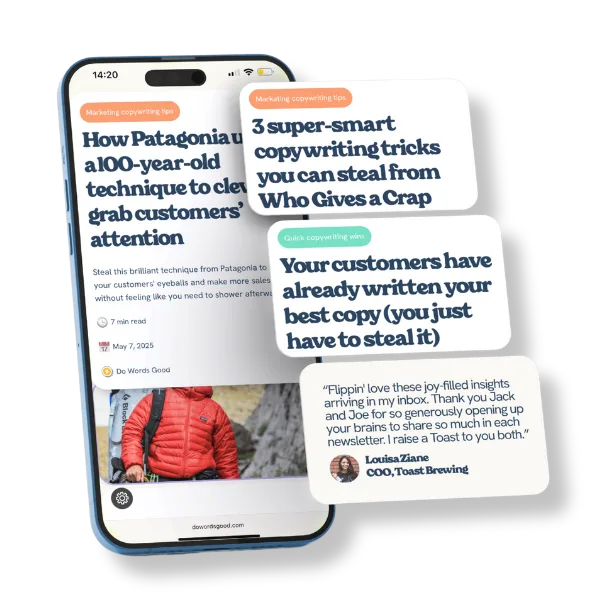
Read every week by legends at brands like these











